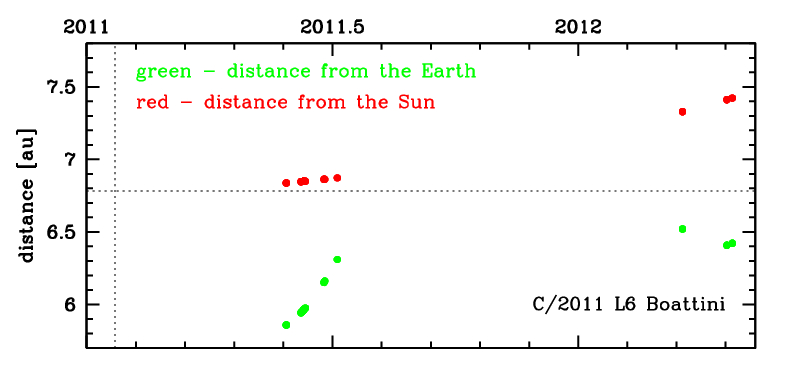C/2011 L6 Boattini
more info
Comet C/2011 L6 was discovered ny Andrea Boattini (Mt Lemmon) on 8 June 2011, that is about 4.5 months after perihelion passage. Soon, the comet was found on earlier images taken on 28 May 2011 with the Mount Lemmon Survey.
Comet had its closest approach to the Earth on 14 May 2011 (5.819 au), about three weeks before discovery.
C/2011 L6 was observed 0.91 yr in a range of heliocentric distances from 6.84 au to 7.42 au.
This comet suffers very small planetary perturbations during its passage through the planetary system that lead to a less tight future orbit with semimjor axis larger than 10000 au. (see future barycentric orbit).
See also Królikowska and Dybczyński 2017.
Comet had its closest approach to the Earth on 14 May 2011 (5.819 au), about three weeks before discovery.
C/2011 L6 was observed 0.91 yr in a range of heliocentric distances from 6.84 au to 7.42 au.
This comet suffers very small planetary perturbations during its passage through the planetary system that lead to a less tight future orbit with semimjor axis larger than 10000 au. (see future barycentric orbit).
See also Królikowska and Dybczyński 2017.
| solution description | ||
|---|---|---|
| number of observations | 56 | |
| data interval | 2011 05 28 – 2012 04 24 | |
| data type | observed only after perihelion (POST) | |
| data arc selection | entire data set (STD) | |
| range of heliocentric distances | 6.84 au – 7.42au | |
| detectability of NG effects in the comet's motion | NG effects not determinable | |
| type of model of motion | GR - gravitational orbit | |
| data weighting | NO | |
| number of residuals | 112 | |
| RMS [arcseconds] | 0.59 | |
| orbit quality class | 1b | |
| next orbit statistics, both Galactic and stellar perturbations were taken into account | ||
|---|---|---|
| no. of returning VCs in the swarm | 4401 | * |
| no. of escaping VCs in the swarm | 600 | |
| no. of hyperbolas among escaping VCs in the swarm | 12 | |
| next reciprocal semi-major axis [10-6 au-1] | 20.34 – 30.34 – 42.87 | R |
| next perihelion distance [au] | 32.1 – 35.4 – 95 | R |
| next aphelion distance [103 au] | 47 – 66 – 98 | R |
| time interval to next perihelion [Myr] | 3.6 – 6 – 11 | R |
| percentage of VCs with qnext > 20 | 100 | |
| next_g orbit statistics, here only the Galactic tide has been included | ||
|---|---|---|
| no. of returning VCs in the swarm | 4497 | * |
| no. of escaping VCs in the swarm | 504 | |
| no. of hyperbolas among escaping VCs in the swarm | 9 | |
| next reciprocal semi-major axis [10-6 au-1] | 20.62 – 30.82 – 43.10 | R |
| next perihelion distance [au] | 0.99 – 3.9 – 170 | R |
| next aphelion distance [103 au] | 46 – 65 – 97 | R |
| time interval to next perihelion [Myr] | 3.5 – 5.8 – 11 | R |
| percentage of VCs with qnext < 10 | 61 | |
| percentage of VCs with 10 < qnext < 20 | 8 | |
| percentage of VCs with qnext > 20 | 31 | |
